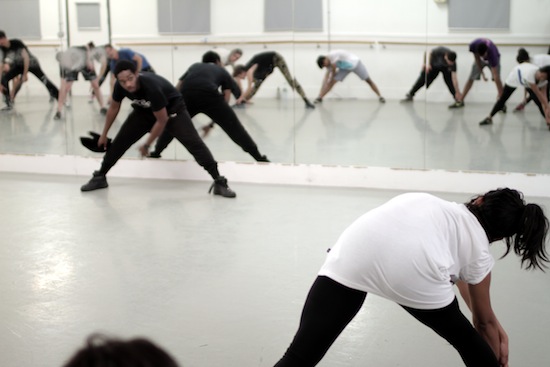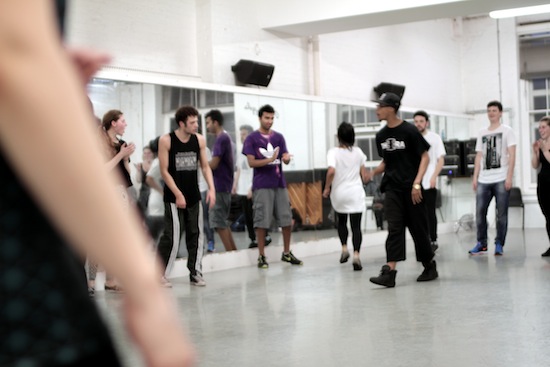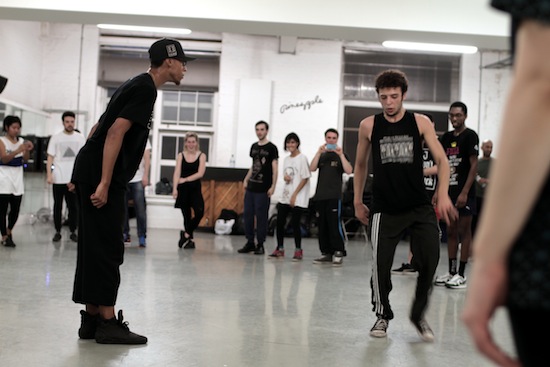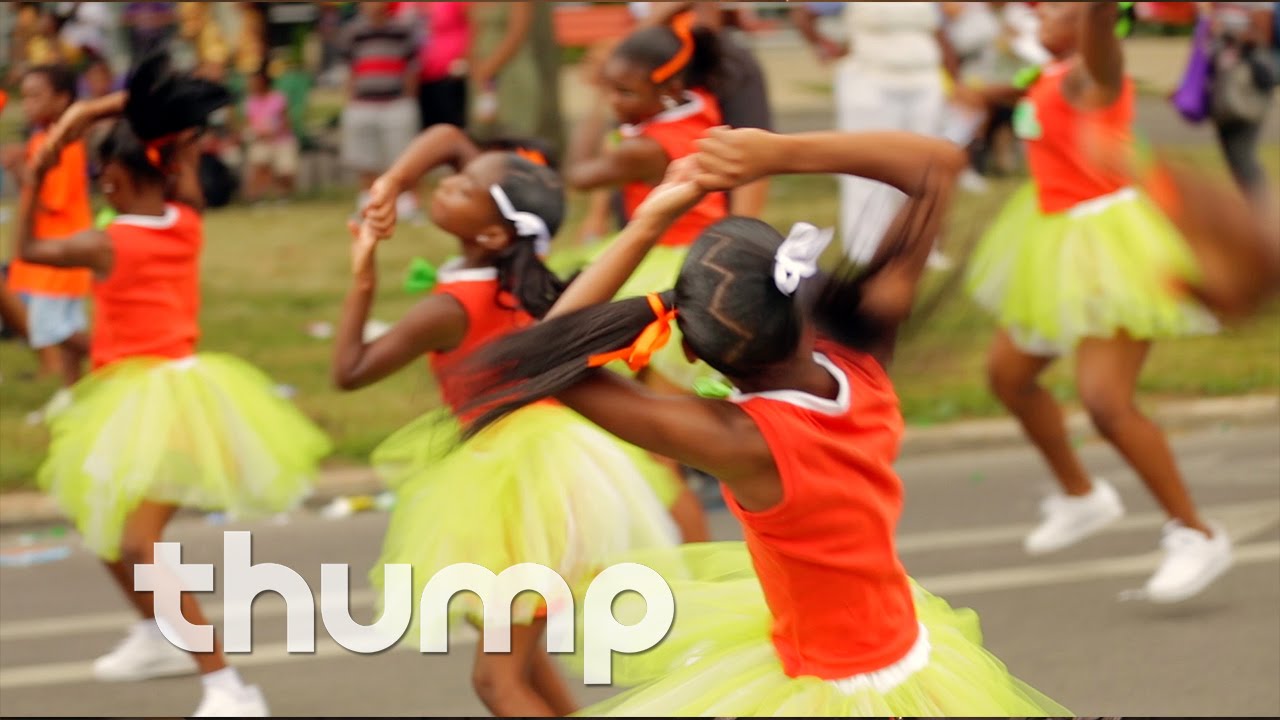When I arrive at Pineapple Dance Studios in central London, the first of The Era’s two footwork classes is just coming to an end. Peeking my head through the door of the studio, I can see a group of twenty or so learners being corralled into a circle by their instructors, Litebulb and Manny. One after the other, they take turns sheepishly stepping into the middle to put into practice the moves they’ve just learned. As I later discover myself, your few seconds of awkward shuffling in the limelight are a humbling experience: my every move is over-thought, lumbering and heavy-footed like I’m three sheets to the wind at a wedding disco. But then an hour-long lesson pales in comparison to the years of practice it takes to become a skilled dancer in Chicago’s footwork scene.
Before the second class can get started in earnest, the tutors give the departing learners an encore to show them how it’s done. Manny starts by pacing around the circle, breaking out into a bout of frenetic footwork just as a burst of chattering snares comes in over the studio’s speakers. In person, footwork seems even faster than it does when watching on YouTube – blink and you’ll miss a move. At times the pair appear to barely touch the ground, shifting so frictionlessly around the floor that it seems like a different law of gravity applies to them. Both Manny and Litebulb’s movements aren’t confined to the bottom-half of the body, as you might expect – with the two working their arms in unison with their legs almost like a marionette. They are at once balletic, twisting and turning on the balls of their feet, and confrontational, swaggering as if they’d stepped into a boxing ring. When the performance comes to an end, Litebulb offers one final word of advice. "Confidence that’s all you need to be a footwork dancer," he says, "notice how I didn’t say skill or speed, none of that – confidence".
Litebulb and Manny have been teaching people how to footwork for nearly two years now. Together they founded The Era in March 2014 and since then they’ve performed and put on workshops in Japan, Latin America, Europe, and, of course, their hometown of Chicago. As the two later explain to me, The Era was initially just an off-shoot of a different group that wanted to dedicate themselves to performing rather than battling against other crews. It wasn’t until last year when Teklife co-founder DJ Spinn suggested to Litebulb that he bring along a second dancer on their next tour that the group finally came into its own. "I thought that if we’re going to be touring internationally then why not do it as a collective," he says. Keen to have the cream of the current crop of dancers among his ranks, Litebulb even made the unprecedented move of recruiting one of his rivals. "I went and got P-Top from a whole different crew than us, he’s from Goon Squad who are based in the north side of the city," he says. There are four additional members that make up The Era: dancers Ste-Lo and Dempsey and Dee-Dee and Dana, who manage the group.
The Era are just one, relatively young, dance crew in Chicago’s footwork scene. Aside from P-Top, The Era’s dancers cut their teeth in a group called Terra Squad; Manny and Litebulb joined when they were just 12. Dance crews are stratified by generation and Terra Squad itself is a successor to Wolf Pac, The Tunnel and Red Legends, the three of which go back over a decade. The older dancers play a pedagogic role: schooling willing youngsters in the basics who then, in turn, branch off and form their own crews; with names like The Legends of the New School or The Nu Era (the original name for The Era) to distinguish themselves. To have been taught by one of the originators is a badge of honour. "We learnt from Ant Brown who was one of the creators of footwork," says Manny proudly, "but our style also stems from TS who were rebels."
In the scene as whole, there’s a tension between mastering the basics, as set out by the elders, and fashioning your own distinctive take on them. "You’re only as great as the person who taught you," says Litebulb, "but if I take your move and make it my own and change it into something new, then you have to learn it now. That’s what evolves the culture." Some crews, as Manny points out, have even made a name for themselves by creating their own school of footwork. "There’s a group called Below Zero, named after [a sample from] RP Boo’s ‘Freezaburn’, that come from 63rd Street, west of the city. They didn’t know any of the legends that could teach them the original style of footwork. So they made their own style with their own basic moves. If you in Below Zero I know it because of how you footworking," he says. "Unique styles can come out of situations like that."
It’s possible to trace the lineage of footwork as a form of dancing back several decades to Chicago’s nascent house scene. In the early 80s, dance groups like K-Phi-9, U-Phi-U, House Arrest 2 and House-O-Matics, which as their names suggest were organised like fraternities, would perform routines at parties and community events. One of the most significant of which is the Bud Billiken Parade, the oldest and largest African-American parade in the United States. Held at the start of the school year, the Bud has long been a showcase for dance groups who perform routines as the parade travels down Martin Luther King Drive from 39th to 55th Street. The route ends at Washington Park, where dancers spill onto the tennis and basketball courts, now enshrined in legend as the setting for some of footwork’s most memorable battles. It’s also there that Litebulb first met the late DJ Rashad and Spinn when he was 16.
The Bud is also an important occasion for the DJs manning the sound systems on the floats, who come armed with tracks produced just for the parade, some of which are even customised for a specific fraternity. With the city’s finest dancers and DJs all in such close proximity, it’s perhaps inevitable that a spark lit at the parade. Both RP Boo, often cited as the genre’s progenitor, and Marcus Hendrix, the founder of U-Phi-U, have given weight to the theory that the Bud was the birthplace of footwork. As Hendrix explained to THUMP in a feature that accompanies Wills Glasspiegel’s short film about the parade, moves from the fraternity’s routines formed the basis of footwork.
Nearly all of scene’s notable DJs danced at one time or another. Many passed through House-O-Matics, which counts among its alumni Boo, DJ Deeon, Spinn and Rashad to name but a few. The troupe, founded in 1985 by Ronnie Sloane, achieved fame outside of Chicago, touring around the state and appearing on regional television. By the mid-90s, a split had begun to emerge in the group. Dancers fell into one of two camps: those that favoured performing a range of styles and those who specialised in footwork. As Sloane recalled in an interview with the Chicago Reader, Spinn and Rashad fell into the latter camp: "they did real dancing just at our parties, because it was everyone in a circle, battlin’ each other, showin’ off – they did great with that. But when it came down to our shows, it was like, ‘OK, well, we’re takin’ you, you, you, and you,’ and they just wasn’t the chosen few.’" Spinn himself admits that they were outsiders in what had become professional outfit. "We was the footwork guys that came in and fucked shit up at the end of the show," he tells me, laughing, "We didn’t learn routines, like fuck it."
Another figure that’s often cited as pivotal to the evolution of footwork is dancer Ant Brown. A former dancer in U-Phi-U, Brown is widely considered to have consolidated a series of moves that almost all beginners still learn to this day. At a practice space known as The Dungeon, the next generation of dancers would come to learn from Brown. As Spinn explained in an interview with Resident Advisor: "Ant was the one who modernised the different styles that are still going on now, and that was back in 1994. It was you either get with Ant Brown and he teach you or you steal his moves and most people stole his moves." These days, he prefers to stay out of the limelight having long since retired from dancing but he’s a cult hero in the scene.

As former pupils of the man himself, The Era might be the next best thing to being taught by Brown. At their London workshop, Manny takes us through the very same basics while Litebulb hovers around the sweltering studio, on hand to assist slow learners like myself. We start off with a move called ‘Erks’, there’s just two steps to it: you kick one foot out, bring it back and then repeat with the opposite. Most footwork moves have similarly literal names, like the ‘Running Man’ and ‘Dribbles’, although some like ‘Tom and Jerry’, for example, refer to their source of inspiration. Next we learn the ‘Skates’, which involves a criss-cross motion and, as Manny demonstrates, is one way of shimmying around the dance circle. Being able to make use of all the space available to you is an important skill as there’s usually only one dancer in the circle at a time during a battle. If you’re feeling particularly belligerent you might even goad your opponents on the sidelines by brushing up against them. The moves themselves are relatively simple; the difficulty comes when trying to keep in time with the music. As the pace quickens, my form goes out the window and I catch myself doing something that resembles Riverdance in the studio’s mirrors.

Footwork’s breakneck speed is what separates it from the dance styles that came before it like juke and jit. As Spinn explains, the catalyst for the shift in tempo was competition between dancers from different areas of the city. "It was a west side thing at first," he says, "they’d play their records at 45 RPM instead 33 and we were like ‘Shit, we got to keep up with these dudes’". With one side of Chicago having thrown down the gauntlet, crews from all corners of the city were now forced to match their speed to compete or lose face. "You’d go out to these dance competitions and somebody would pull that rabbit trick out their hat and they’d win. So everybody now like ‘We gotta try that,’" RP Boo explained in a Resident Advisor podcast.
When I meet Manny and Litebulb again, later that evening at Corsica Studios, I ask them how they manage to cope with dancing for long periods at such an exhausting pace. "I could dance for three hours, Spinn’s had to tell me to stop before," responds Litebulb, perplexed by my question. Both him and Manny are due to perform during Spinn’s set in a few hours time but for now they’re enjoying a brief respite with Teklife’s DJ Paypal and Taso both of whom are also in London for Kode9’s album launch party. Spinn, who’s been hovering in the background of our conversation, chimes in on hearing his name mentioned: "I seen this boy come out of his body and come right back in. Like Bulb don’t even know what he just did, he’s like ‘Bro, I’m just going’". Manny concurs: "It’s like I can’t not dance to this. I call it the footwork holy ghost, some tracks I hear and I just. can’t. not. move. It’s some spiritual shit."
Manny and Litebulb might only be a generation apart from Spinn but much has changed in the intervening years. Today, footwork dancing is mostly confined to a circuit of competitive events, although that hasn’t always been the case. To begin with, the dancing was a sideshow at parties. "When I was growing up, it was a party and you could battle if you want to or juke on girls. But now it’s like ‘Fuck the party, let’s just go battle each other’ and it’s lost something," says Manny. The pair are particularly critical of the move towards events presided over by judges. "People knew in their mind if they’d lost, and they’d go home and think about it and practice. That’s missing now because we got judges as oppose to you knowing the crowd is behind you and you killing it," Manny adds.
As footwork has found an audience abroad over the last few years, in Chicago the scene seems to have waned. "People just lost interest," admits Litebulb. "Back when we started there use to be loads of events: Union Hall, House of Kicks, Markham Skating Rink, Route 66. Over time the parties grew smaller and now there’s just this one spot where it’s happening, Battlegroundz." After five years of touring, however, he’s keen to turn his attention back to his hometown. "I’m focused on Chicago now and how disconnected a lot of things are in our city and culture. A lot of people don’t know who we are, or even who Spinn and Rashad are." Earlier this year, Litebulb was awarded a $15,000 grant by arts organisation Chicago Dancemakers Forum which, with the help of The Era, he plans to use to get people footworking once more. "We gonna bring the culture back to the city and spread it out again. We spread it everywhere but what about home, they love us too, they remember us. Chicago was built on dancers," he says.
One of the challenges The Era face is broadening the appeal of footwork as a dance form beyond a competitive coterie. For Manny, that means trying to find a new medium for footwork. "A perfect analogy is battle rap," he explains, "rap evolved from battling into songs. We’re trying to do the same thing for footwork. We’ve been battling for a long time, going up against crews so what’s the next step? What’s the song for footwork crews?" The Era’s strategy so far has been to branch out into music videos of their own. Last August, the group released a slickly-produced short film of themselves footworking around their neighbourhood to Spinn’s remix of Kanye West’s ‘All Day’ on their YouTube channel. It features both solo performances and, uniquely, a choreographed group routine. As Litebulb explains, the intention was to show that dancers are artists in their own right. "We represent that you don’t gotta be no background dancer for nobody. You are the acts yourself. That’s why we produced a dance music video," he says.

For Manny and Litebulb, the lack of appreciation for dancers has been an ongoing frustration. Despite being integral to footwork, dancers have found themselves sidelined while producers and DJs have travelled far beyond Chicago. "We realised ‘Damn, these people don’t see the importance of us’ so [we’re going to] have to show you," says Manny. "We the show, there ain’t no show without the dancers," adds Litebulb. Those collaborations have made for some of the most memorable performances in recent years. Back in 2014, Litebulb tore up the Barbican together with Traxman at Just Jam, and, in October, experimental dancer Avril Stormy Unger brought to life the twisted sounds of Jlin’s productions at her debut live show at Unsound festival. Unger might not come from a footwork background but she nevertheless underscored how crucial a component dancing is to understanding the music. Footwork is intended to be mediated through bodies – movement is its language. As Litebulb puts it: "We they voice, we always have been they voice."
The Era have ambitions for footwork that go beyond Chicago. One of the group’s collective goals is to gain recognition for footwork as a dance form on the world stage. But as Litebulb tells me, there are many barriers they have yet to overcome. "You can’t say you’re a dancer for a living and have people take you seriously, it’s unthought of. And if you are a dancer and taken seriously it’s because you’re doing it in tights. People think we’re rappers, that’s the reality. We deserve the same respect as other professional dancers," he says. "When we’re heading to a show and we got our Era or Teklife T-shirts on people ask us ‘Are y’all a rap group?’ When we tell them we’re dancers, they look at us like ‘What?’ Like it’s unbelievable that we could be dancers," Manny adds.
Over the past few years, The Era’s mission has taken on a more personal dimension. In 2010, Litebulb and Manny lost one of their close friends, Jeremiah Sterling, after he was shot thirteen times just a block away from his home. He was 16 when he was killed. The two came to know Sterling through Terra Squad, where he’d made a name for himself as one of the most promising dancers among the crew’s young recruits, garnering the titles ‘Miah the Great’ and ‘The Youngest in Charge’. It was also Sterling that first gave Litebulb the idea to start teaching footwork. Four years later, the crew suffered another loss when DJ Rashad, who was both a friend and mentor, died of an overdose. "I remember I met him and Spinn at a party and he was like ‘Oh these the new motherfuckers in TS’ but we didn’t get to know each other until I went over to Spinn’s basement," recalls Manny. The two would hangout with Rashad and Spinn dancing to their work-in-progress productions. One of Rashad’s tracks ‘Ghost’ even features a shout out to Litebulb together with the city’s foremost dancers at the time A.G, Que and Pooh. Before he died in April 2014, Rashad had also been advocating incorporating more dancing into Teklife’s live shows. The Era have not only realised that vision but have kept his legacy alive by continuing touring in his stead. "They’re are our motivation," says Litebulb of Rashad and Jeremiah, "we’ve been traveling and teaching ever since to push our culture to get it considered as art."

Last year, Manny and Litebulb travelled to Japan, following in Spinn and Rashad’s footsteps, and they talk enthusiastically of the footwork scene that has flourished in Hiroshima, Osaka and, primarily, Tokyo. "The proudest thing for me was that Japan picked up on the culture, they have parties where people go to footwork," says Manny. "That’s what I live for, to keep the scene going as a culture. We want people to fuck with the whole culture, not just with the music." At a time when local music scenes are rapidly globalised, often with little or no regard paid to the context from which they originated, Manny and Litebulb’s efforts to educate people are perhaps one way of regaining some agency over the process. In their quest to ensure that dancing is recognised on equal footing with the music, the pair have taken on the role of the scene’s missionaries, or at the very least, its ambassadors. It’s a lot perhaps to shoulder but Spinn is confident that The Era are up to the task. "It’s like y’all dancing for the world right now because I don’t know no dance culture as intriguing as what we do," he tells the two proudly.




